steering FIAT DOBLO COMBI 2015 2.G User Guide
[x] Cancel search | Manufacturer: FIAT, Model Year: 2015, Model line: DOBLO COMBI, Model: FIAT DOBLO COMBI 2015 2.GPages: 323, PDF Size: 46.77 MB
Page 44 of 323
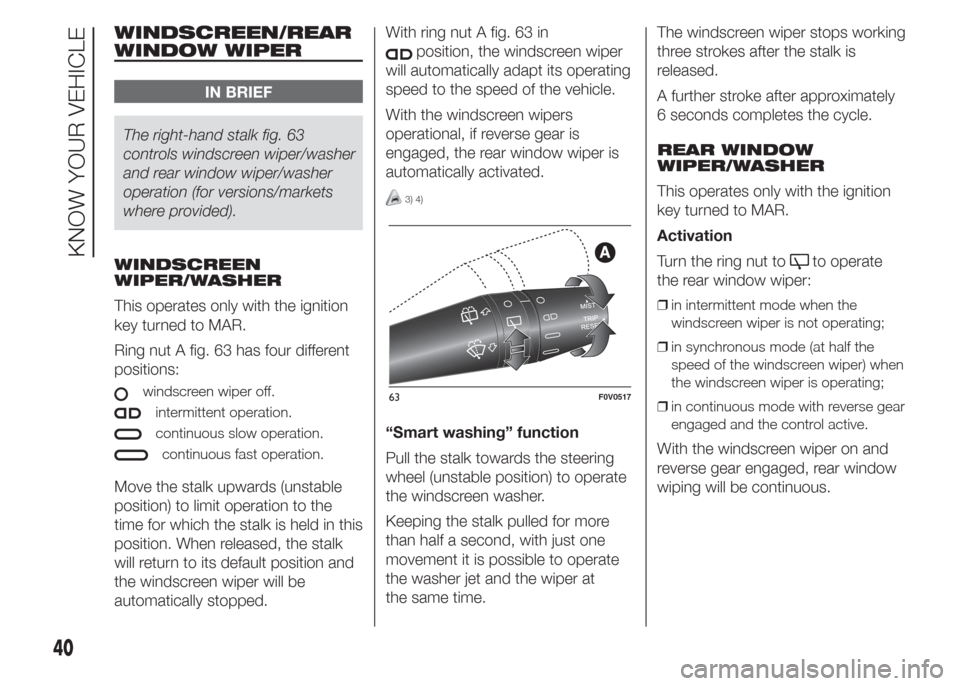
WINDSCREEN/REAR
WINDOW WIPER
IN BRIEF
The right-hand stalk fig. 63
controls windscreen wiper/washer
and rear window wiper/washer
operation (for versions/markets
where provided).
WINDSCREEN
WIPER/WASHER
This operates only with the ignition
key turned to MAR.
Ring nut A fig. 63 has four different
positions:
windscreen wiper off.
intermittent operation.
continuous slow operation.
continuous fast operation.
Move the stalk upwards (unstable
position) to limit operation to the
time for which the stalk is held in this
position. When released, the stalk
will return to its default position and
the windscreen wiper will be
automatically stopped.With ring nut A fig. 63 in
position, the windscreen wiper
will automatically adapt its operating
speed to the speed of the vehicle.
With the windscreen wipers
operational, if reverse gear is
engaged, the rear window wiper is
automatically activated.
3) 4)
“Smart washing” function
Pull the stalk towards the steering
wheel (unstable position) to operate
the windscreen washer.
Keeping the stalk pulled for more
than half a second, with just one
movement it is possible to operate
the washer jet and the wiper at
the same time.The windscreen wiper stops working
three strokes after the stalk is
released.
A further stroke after approximately
6 seconds completes the cycle.
REAR WINDOW
WIPER/WASHER
This operates only with the ignition
key turned to MAR.
Activation
Turn the ring nut to
to operate
the rear window wiper:
❒in intermittent mode when the
windscreen wiper is not operating;
❒in synchronous mode (at half the
speed of the windscreen wiper) when
the windscreen wiper is operating;
❒in continuous mode with reverse gear
engaged and the control active.
With the windscreen wiper on and
reverse gear engaged, rear window
wiping will be continuous.
63F0V0517
40
KNOW YOUR VEHICLE
Page 131 of 323
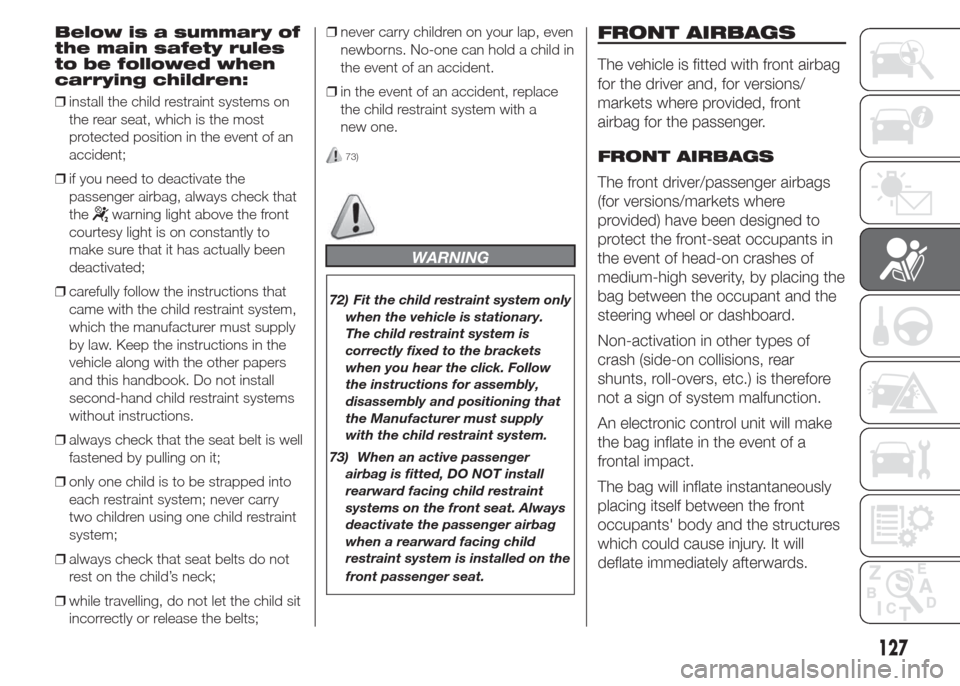
Below is a summary of
the main safety rules
to be followed when
carrying children:
❒install the child restraint systems on
the rear seat, which is the most
protected position in the event of an
accident;
❒if you need to deactivate the
passenger airbag, always check that
the
warning light above the front
courtesy light is on constantly to
make sure that it has actually been
deactivated;
❒carefully follow the instructions that
came with the child restraint system,
which the manufacturer must supply
by law. Keep the instructions in the
vehicle along with the other papers
and this handbook. Do not install
second-hand child restraint systems
without instructions.
❒always check that the seat belt is well
fastened by pulling on it;
❒only one child is to be strapped into
each restraint system; never carry
two children using one child restraint
system;
❒always check that seat belts do not
rest on the child’s neck;
❒while travelling, do not let the child sit
incorrectly or release the belts;❒never carry children on your lap, even
newborns. No-one can hold a child in
the event of an accident.
❒in the event of an accident, replace
the child restraint system with a
new one.
73)
WARNING
72) Fit the child restraint system only
when the vehicle is stationary.
The child restraint system is
correctly fixed to the brackets
when you hear the click. Follow
the instructions for assembly,
disassembly and positioning that
the Manufacturer must supply
with the child restraint system.
73) When an active passenger
airbag is fitted, DO NOT install
rearward facing child restraint
systems on the front seat. Always
deactivate the passenger airbag
when a rearward facing child
restraint system is installed on the
front passenger seat.
FRONT AIRBAGS
The vehicle is fitted with front airbag
for the driver and, for versions/
markets where provided, front
airbag for the passenger.
FRONT AIRBAGS
The front driver/passenger airbags
(for versions/markets where
provided) have been designed to
protect the front-seat occupants in
the event of head-on crashes of
medium-high severity, by placing the
bag between the occupant and the
steering wheel or dashboard.
Non-activation in other types of
crash (side-on collisions, rear
shunts, roll-overs, etc.) is therefore
not a sign of system malfunction.
An electronic control unit will make
the bag inflate in the event of a
frontal impact.
The bag will inflate instantaneously
placing itself between the front
occupants' body and the structures
which could cause injury. It will
deflate immediately afterwards.
127
Page 132 of 323
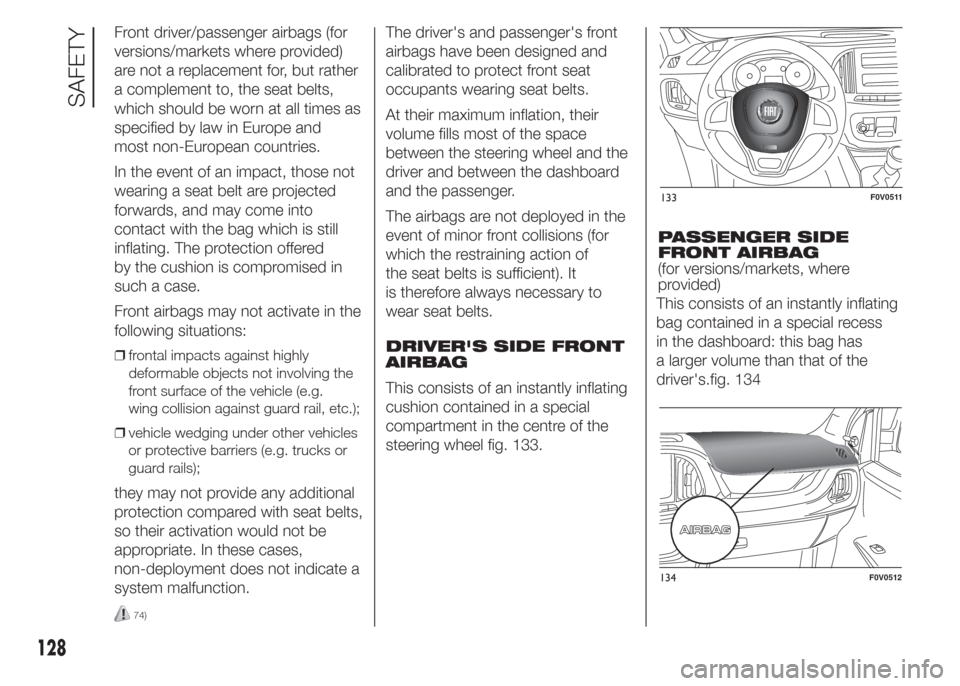
Front driver/passenger airbags (for
versions/markets where provided)
are not a replacement for, but rather
a complement to, the seat belts,
which should be worn at all times as
specified by law in Europe and
most non-European countries.
In the event of an impact, those not
wearing a seat belt are projected
forwards, and may come into
contact with the bag which is still
inflating. The protection offered
by the cushion is compromised in
such a case.
Front airbags may not activate in the
following situations:
❒frontal impacts against highly
deformable objects not involving the
front surface of the vehicle (e.g.
wing collision against guard rail, etc.);
❒vehicle wedging under other vehicles
or protective barriers (e.g. trucks or
guard rails);
they may not provide any additional
protection compared with seat belts,
so their activation would not be
appropriate. In these cases,
non-deployment does not indicate a
system malfunction.
74)
The driver's and passenger's front
airbags have been designed and
calibrated to protect front seat
occupants wearing seat belts.
At their maximum inflation, their
volume fills most of the space
between the steering wheel and the
driver and between the dashboard
and the passenger.
The airbags are not deployed in the
event of minor front collisions (for
which the restraining action of
the seat belts is sufficient). It
is therefore always necessary to
wear seat belts.
DRIVER'S SIDE FRONT
AIRBAG
This consists of an instantly inflating
cushion contained in a special
compartment in the centre of the
steering wheel fig. 133.PASSENGER SIDE
FRONT AIRBAG
(for versions/markets, where
provided)
This consists of an instantly inflating
bag contained in a special recess
in the dashboard: this bag has
a larger volume than that of the
driver's.fig. 134
133F0V0511
134F0V0512
128
SAFETY
Page 135 of 323
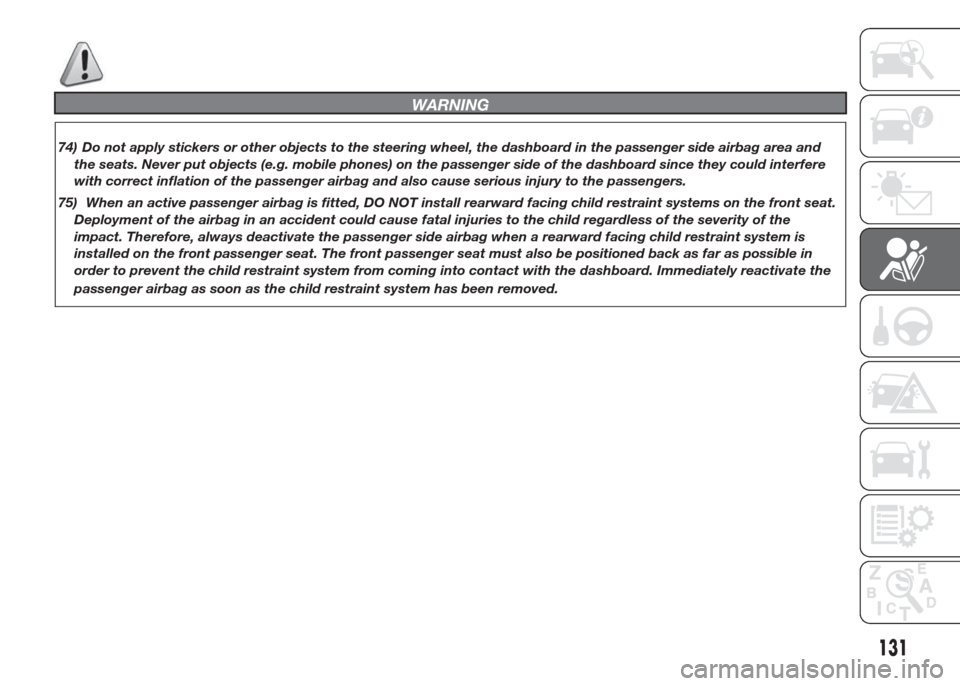
WARNING
74) Do not apply stickers or other objects to the steering wheel, the dashboard in the passenger side airbag area and
the seats. Never put objects (e.g. mobile phones) on the passenger side of the dashboard since they could interfere
with correct inflation of the passenger airbag and also cause serious injury to the passengers.
75) When an active passenger airbag is fitted, DO NOT install rearward facing child restraint systems on the front seat.
Deployment of the airbag in an accident could cause fatal injuries to the child regardless of the severity of the
impact. Therefore, always deactivate the passenger side airbag when a rearward facing child restraint system is
installed on the front passenger seat. The front passenger seat must also be positioned back as far as possible in
order to prevent the child restraint system from coming into contact with the dashboard. Immediately reactivate the
passenger airbag as soon as the child restraint system has been removed.
131
Page 151 of 323
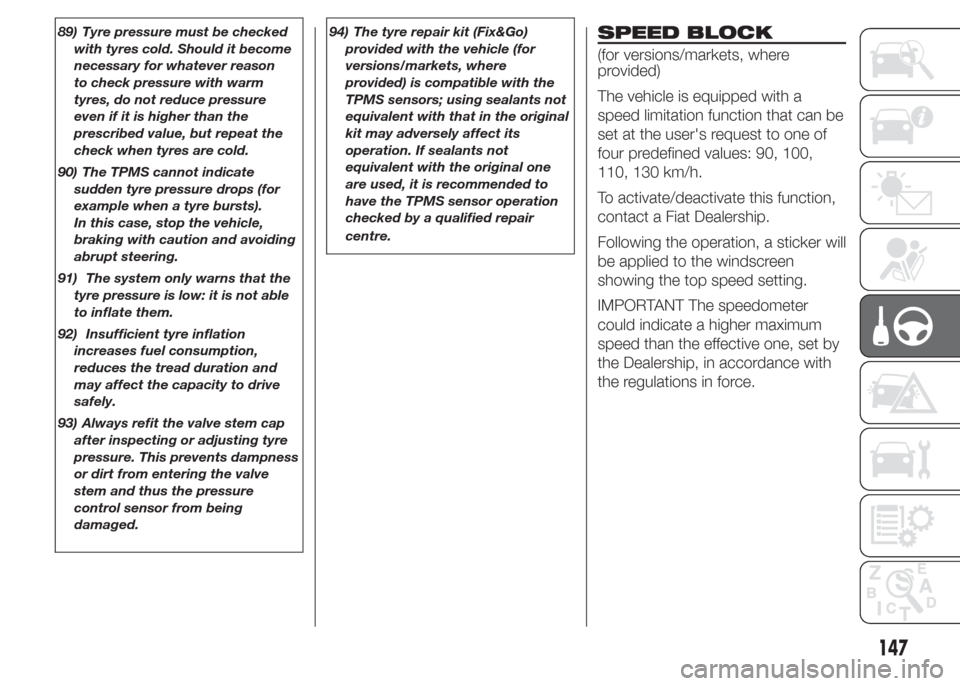
89) Tyre pressure must be checked
with tyres cold. Should it become
necessary for whatever reason
to check pressure with warm
tyres, do not reduce pressure
even if it is higher than the
prescribed value, but repeat the
check when tyres are cold.
90) The TPMS cannot indicate
sudden tyre pressure drops (for
example when a tyre bursts).
In this case, stop the vehicle,
braking with caution and avoiding
abrupt steering.
91) The system only warns that the
tyre pressure is low: it is not able
to inflate them.
92) Insufficient tyre inflation
increases fuel consumption,
reduces the tread duration and
may affect the capacity to drive
safely.
93) Always refit the valve stem cap
after inspecting or adjusting tyre
pressure. This prevents dampness
or dirt from entering the valve
stem and thus the pressure
control sensor from being
damaged.94) The tyre repair kit (Fix&Go)
provided with the vehicle (for
versions/markets, where
provided) is compatible with the
TPMS sensors; using sealants not
equivalent with that in the original
kit may adversely affect its
operation. If sealants not
equivalent with the original one
are used, it is recommended to
have the TPMS sensor operation
checked by a qualified repair
centre.SPEED BLOCK
(for versions/markets, where
provided)
The vehicle is equipped with a
speed limitation function that can be
set at the user's request to one of
four predefined values: 90, 100,
110, 130 km/h.
To activate/deactivate this function,
contact a Fiat Dealership.
Following the operation, a sticker will
be applied to the windscreen
showing the top speed setting.
IMPORTANT The speedometer
could indicate a higher maximum
speed than the effective one, set by
the Dealership, in accordance with
the regulations in force.
147
Page 178 of 323
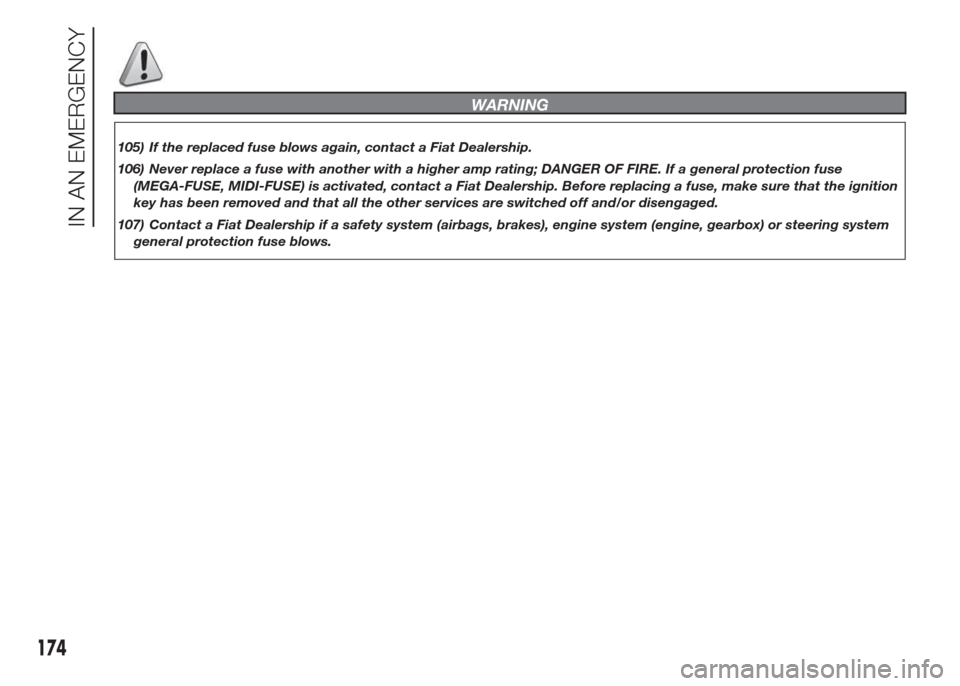
WARNING
105) If the replaced fuse blows again, contact a Fiat Dealership.
106) Never replace a fuse with another with a higher amp rating; DANGER OF FIRE. If a general protection fuse
(MEGA-FUSE, MIDI-FUSE) is activated, contact a Fiat Dealership. Before replacing a fuse, make sure that the ignition
key has been removed and that all the other services are switched off and/or disengaged.
107) Contact a Fiat Dealership if a safety system (airbags, brakes), engine system (engine, gearbox) or steering system
general protection fuse blows.
174
IN AN EMERGENCY
Page 188 of 323
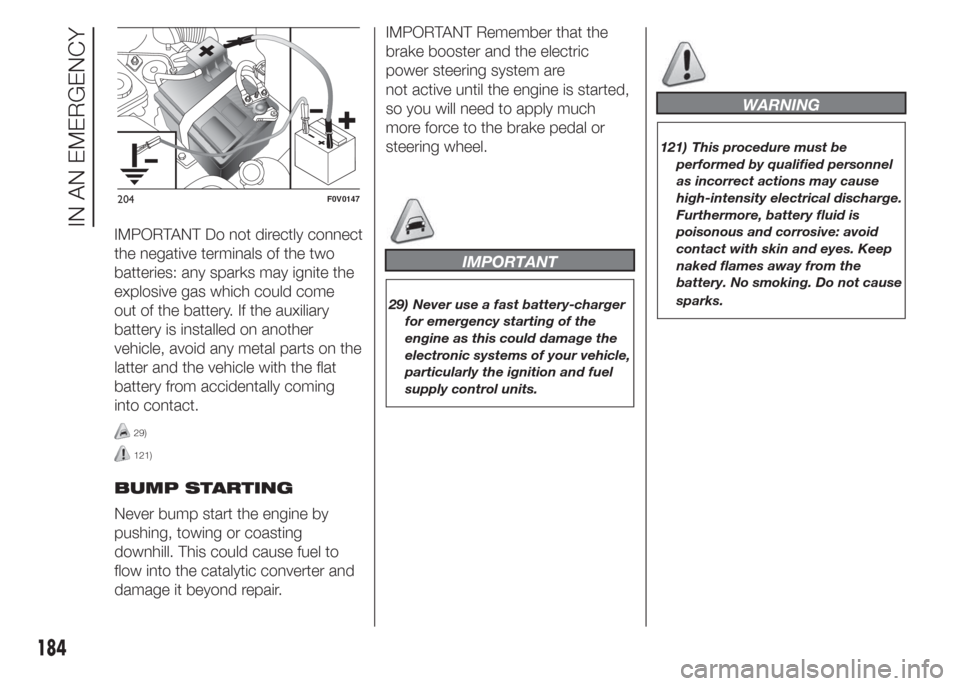
IMPORTANT Do not directly connect
the negative terminals of the two
batteries: any sparks may ignite the
explosive gas which could come
out of the battery. If the auxiliary
battery is installed on another
vehicle, avoid any metal parts on the
latter and the vehicle with the flat
battery from accidentally coming
into contact.
29)
121)
BUMP STARTING
Never bump start the engine by
pushing, towing or coasting
downhill. This could cause fuel to
flow into the catalytic converter and
damage it beyond repair.IMPORTANT Remember that the
brake booster and the electric
power steering system are
not active until the engine is started,
so you will need to apply much
more force to the brake pedal or
steering wheel.
IMPORTANT
29) Never use a fast battery-charger
for emergency starting of the
engine as this could damage the
electronic systems of your vehicle,
particularly the ignition and fuel
supply control units.
WARNING
121) This procedure must be
performed by qualified personnel
as incorrect actions may cause
high-intensity electrical discharge.
Furthermore, battery fluid is
poisonous and corrosive: avoid
contact with skin and eyes. Keep
naked flames away from the
battery. No smoking. Do not cause
sparks.
204F0V0147
184
IN AN EMERGENCY
Page 190 of 323
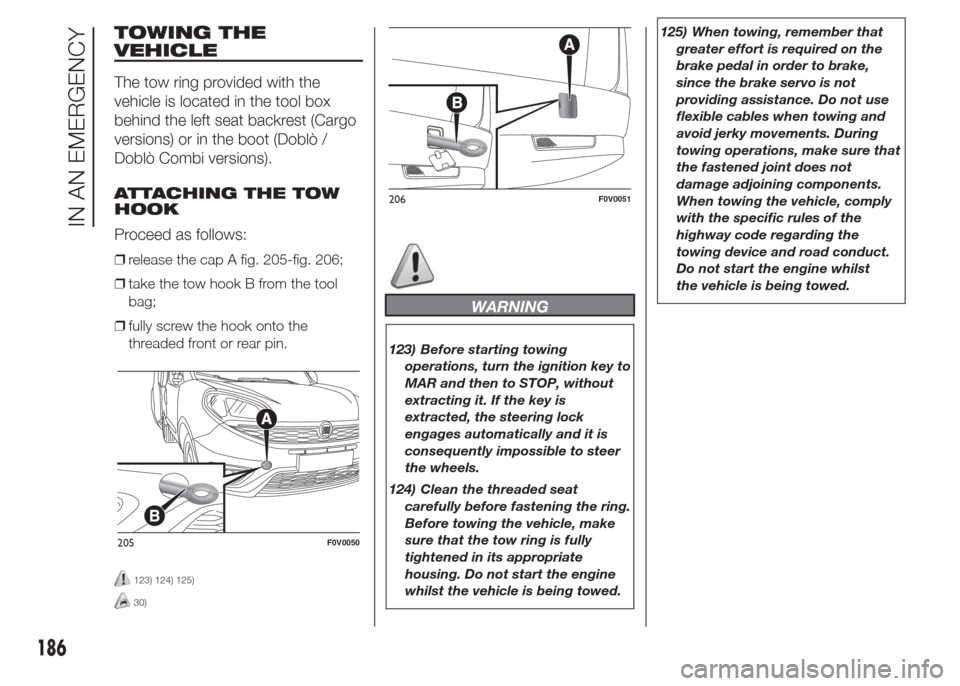
TOWING THE
VEHICLE
The tow ring provided with the
vehicle is located in the tool box
behind the left seat backrest (Cargo
versions) or in the boot (Doblò /
Doblò Combi versions).
ATTACHING THE TOW
HOOK
Proceed as follows:
❒release the cap A fig. 205-fig. 206;
❒take the tow hook B from the tool
bag;
❒fully screw the hook onto the
threaded front or rear pin.
123) 124) 125)
30)
WARNING
123) Before starting towing
operations, turn the ignition key to
MAR and then to STOP, without
extracting it. If the key is
extracted, the steering lock
engages automatically and it is
consequently impossible to steer
the wheels.
124) Clean the threaded seat
carefully before fastening the ring.
Before towing the vehicle, make
sure that the tow ring is fully
tightened in its appropriate
housing. Do not start the engine
whilst the vehicle is being towed.125) When towing, remember that
greater effort is required on the
brake pedal in order to brake,
since the brake servo is not
providing assistance. Do not use
flexible cables when towing and
avoid jerky movements. During
towing operations, make sure that
the fastened joint does not
damage adjoining components.
When towing the vehicle, comply
with the specific rules of the
highway code regarding the
towing device and road conduct.
Do not start the engine whilst
the vehicle is being towed.
205F0V0050
206F0V0051
186
IN AN EMERGENCY
Page 203 of 323
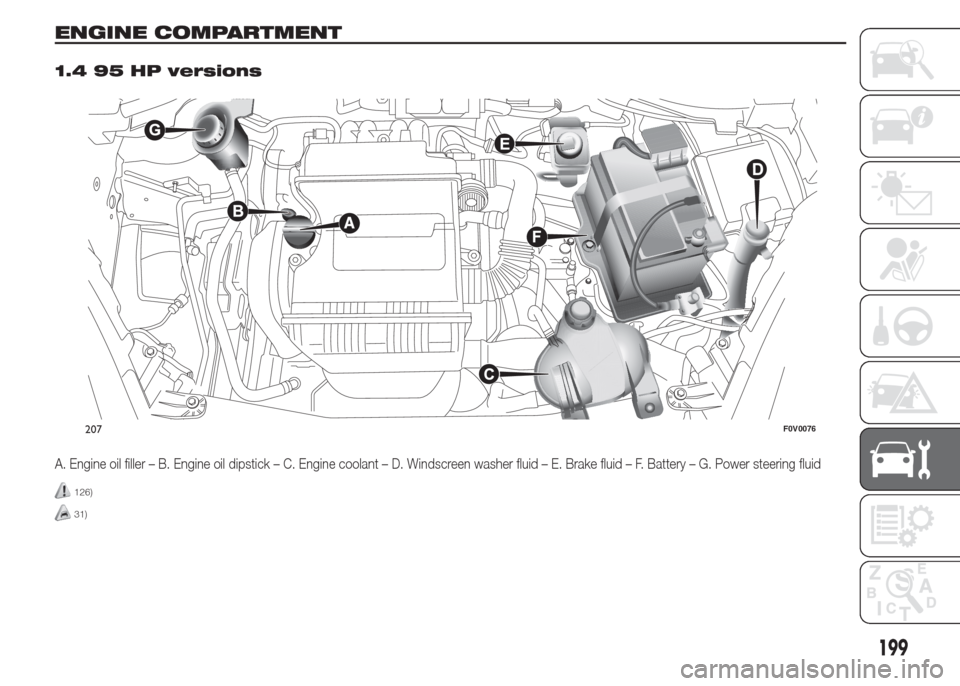
ENGINE COMPARTMENT.
1.4 95 HP versions
A. Engine oil filler – B. Engine oil dipstick – C. Engine coolant – D. Windscreen washer fluid – E. Brake fluid – F. Battery – G. Power steering fluid
126)
31)
207F0V0076
199
Page 204 of 323
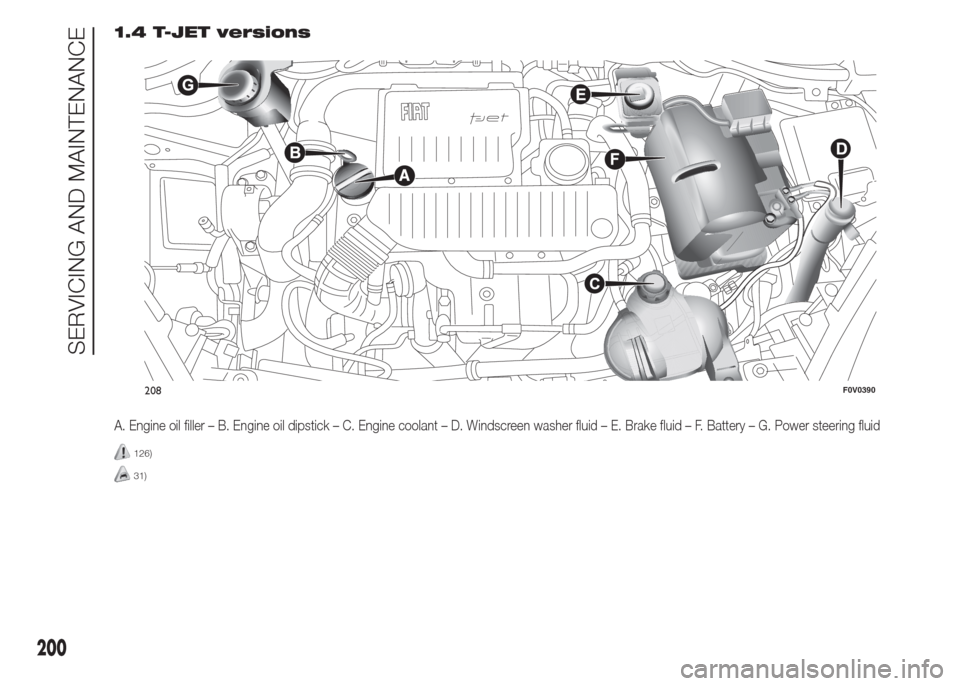
1.4 T-JET versions
A. Engine oil filler – B. Engine oil dipstick – C. Engine coolant – D. Windscreen washer fluid – E. Brake fluid – F. Battery – G. Power steering fluid
126)
31)
208F0V0390
200
SERVICING AND MAINTENANCE